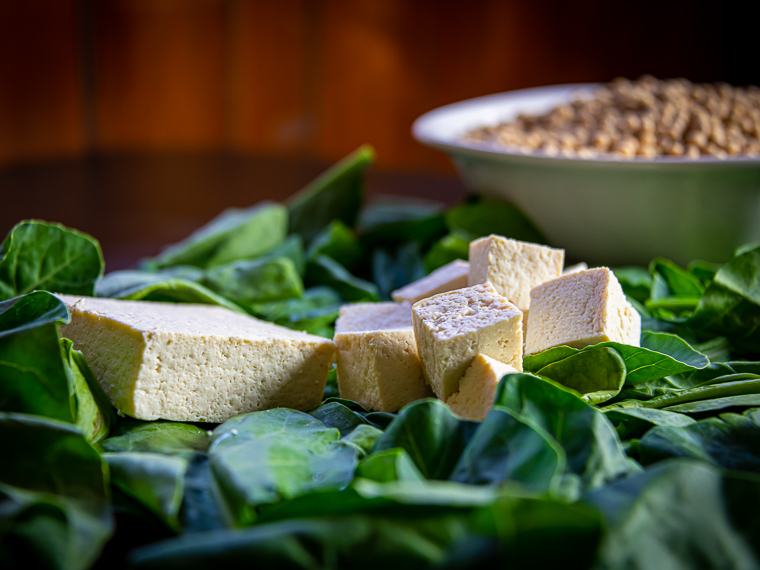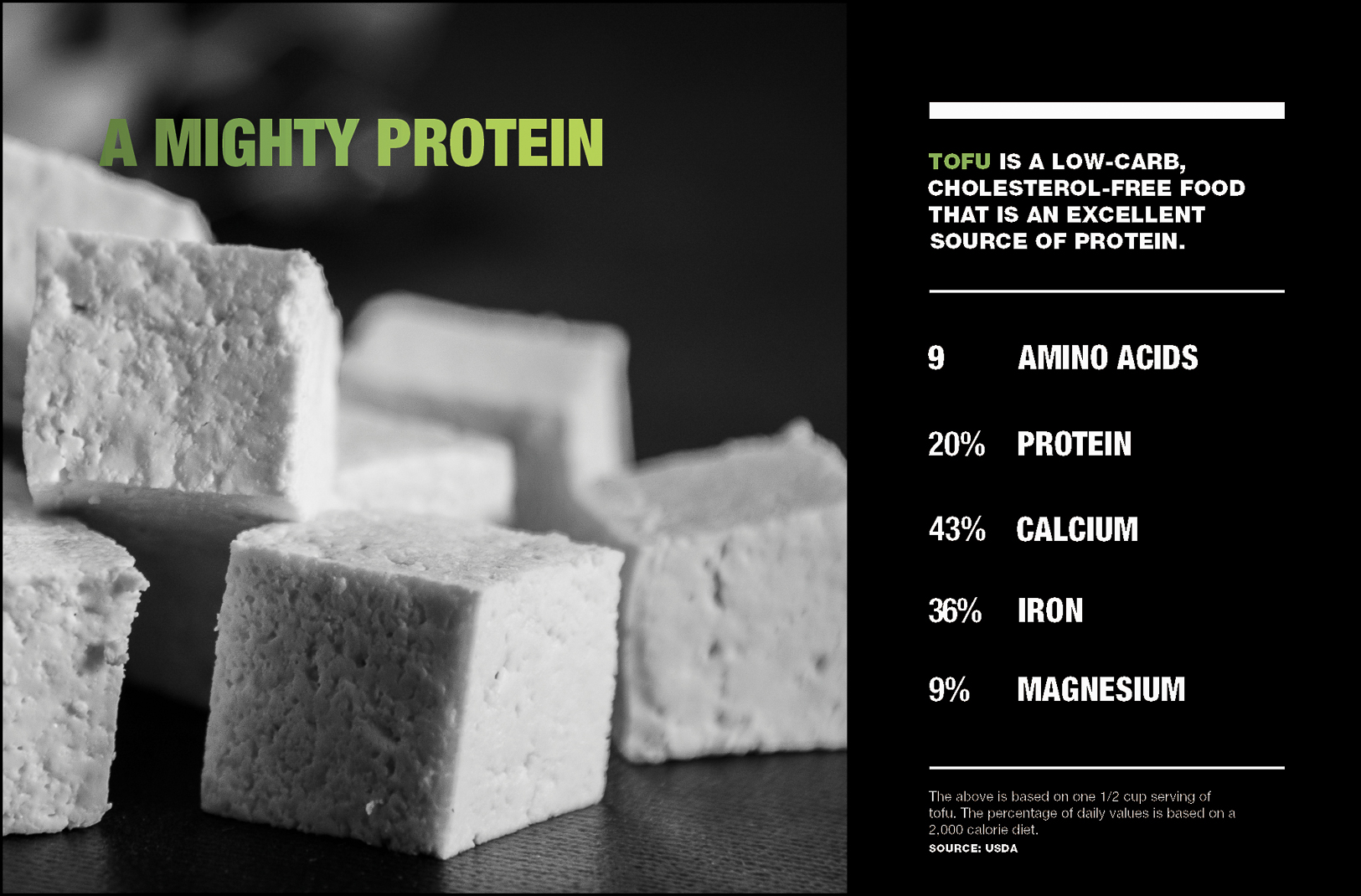The information presented on this page may be dated. It may refer to situations which have changed or people who are no longer affiliated with the university. It is archived as part of Mississippi State University's history.
FROM CRAYONS TO SOY MILK TO ANIMAL FEED, soybeans are versatile and a mainstay in Mississippi agriculture. The row crop is one of the state's top commodities, with a value of $1.21 billion in 2020.
While the legume is used in a variety of products, perhaps the most popular food derived from soybean is tofu. In a process similar to cheesemaking, tofu is made of coagulated soy milk that is formed into solid white blocks with or without pressing. It is a popular ingredient in Asian and vegetarian cuisines.
Tofu is classified by texture from soft, or silken, to medium to firm and extra firm. The firmer the tofu, the more likely it is to hold up to a variety of cooking methods. Dr. Sam Chang, MAFES scientist and professor in the Department of Food Science, Nutrition and Health Promotion at the Coastal Research and Extension Center, hopes to unlock aspects of the row crop to make better tofu. The food scientist finds himself in a unique situation.
"Normally, agronomists and horticulturalists bring crops to food scientists for analysis," Chang said. "This time, it was a food scientist going to agronomists and geneticists and saying, 'Here is what we think will make good tofu. Now, grow it.' It's unusual for a food scientist to conduct plant production research and I appreciate the support to be able to conduct this study."
The study has spanned nine years and involved several scientists. It began when Chang and Shi Meng, a food science, nutrition and health promotion graduate student, hypothesized that soybeans with higher levels of the A3 protein-an acidic subunit of glycinin, one of the two major components in soybean protein-had a firmer texture.
"Because tofu is measured by texture, and the firmer the better, we need to find the right soybean genetics that are food grade," Chang said. "We want to find soybean characteristics that make better tofu, and what we found is this A3 subunit. We proved that soybean cultivars with high A3 subunits have better, firmer texture which can be used to produce better, more desirable tofu."
Chang notes that tofu is primarily made from proteins, hence the significance of the correlation. Soybean proteins are large and consist of a globular protein body composed of several distinct protein molecules, also known as subunits. After proving that the A3 subunit does have an effect on the firmness of tofu, Chang and his team of collaborators, including scientists from the USDA-ARS in Stoneville, Mississippi; the University of Missouri; and Virginia Tech, sought to determine the properties of the selected soybean varieties and the effect the field environment had on the presence and utility of the A3 subunit.
"We confirmed that soybeans with increased levels of the A3 subunit produce firmer tofu, but now we want to know if the environment makes a difference. We want to see if we can grow the same soybeans in different states and still have that relationship and characteristic hold," Chang said. "If we confirm that the A3 component is the critical factor and not affected by environmental and seasonal effect, then we can use this A3 component as a quality factor for improvement of soybean cultivars either by breeding or genetic manipulation."
Twenty-two soybean varieties were selected for the original research from a field of over 10,000 lines from USDA's soybean germplasm database. The twenty-two were chosen for their high-protein content and agronomic traits. The beans were grown in Stoneville for biochemical analysis and texture and sensory quality tests. The team characterized seed chemical composition; analyzed protein composition and content; as well as quantities of the major storage proteins, including the A3 subunit. While doing so, they also made tofu from each of the soybean varieties and chemically analyzed them to determine their textural quality. A statistical analysis was then conducted to show that A3 level was highly related to tofu firmness.
To test for environmental effects, the scientists planted the 22 lines in three different locations: Stoneville, Mississippi; Portageville, Missouri; and Blacksburg, Virginia. The goal was to test if differences in geography and climate over a two-year period affected the A3 protein. "Texture property is the most important quality factor for tofu products. We try to improve tofu by enhancing the critical components in soybean, and our results showed that the A3 component is indeed a reliable factor for predicting quality of soybean varieties for making tofu. Our results showed environment has some impacts, however, it does not affect the correlation of the expression of the A3 protein and tofu firmness, and these results indicate A3 may be used as an indicator of seed quality in multiple environments," Chang said.
He also noted that the most important takeaway for producers lies not in the firmness of tofu but rather in how they should approach growing soybeans as this will have the greatest economic impact for them. About 500,000 tons of soybeans are used each year to produce tofu, according to the Japan Tofu Association.
"Our research is about helping farmers succeed. By growing food-grade soybean, producers stand to increase their selling price by 30 percent," Chang said. "Increasing the market for food-grade soybeans provides better return for farmers. Food processing industries need high quality soybeans for producing desirable products to meet the protein demand of the consumers."
Chang added, "Helping American farmers grow high quality soybeans is what inspired this research, which connects agriculture to food, from genetics to land to table. It will help promote soybean foods for meeting protein requirements of the growing population."
Dr. Anne Gillen, a research geneticist with the USDA-ARS in Stoneville, Mississippi, collaborated on the research to help with soybean breeding.
"As a research geneticist, a majority of my role centers on applied soybean breeding," Gillen said. "Our program focuses on seed increases, trials, and evaluating the agronomics of the trial. This is the first time I have been involved in studying the properties of soybeans that make good tofu."
Gillen said she believes the end users will be the most impacted by this research.
"This is basic research to see how the A3 subunit affects tofu firmness and whether that's something we should be selecting," Gillen said. "Understanding this correlation will help breeders develop soybean lines that meet the standards for the final product. Firmness is one of the standards for tofu production. Knowing what protein level is required to make acceptable tofu, and if there is an optimal protein sub-unit composition, gives breeders a quantifiable breeding target. The overall idea is to develop food soybean lines for the U.S. that have an optimal composition, and it is only just beginning, especially in the South."
Gillen noted that this an area of emerging interest.
"There is a growing interest in food made from soybeans including edamame, natto, and soy milk. Now, public breeders can have a role in developing food soybean lines, and we can further develop programs and the market," she said.
This research was funded by the USDA Agricultural Research Service, the USDA National Institute of Food and Agriculture, and the Mississippi Agricultural and Forestry Experiment Station. In addition to Chang and Gillen, Dr. Pengyin Chen, University of Missouri; Dr. Bo Zhang, Virginia Polytechnic Institute and State University; and Ruiqi Chen and Shi Meng, former master's students in the MSU Department of Food Science, Nutrition and Health Promotion, contributed to this study.
Helping American farmers grow high quality soybeans is what inspired this research, which connects agriculture to food, from genetics to land to table. It will help promote soybean foods for meeting protein requirements of the growing population.
Dr. Sam Chang


